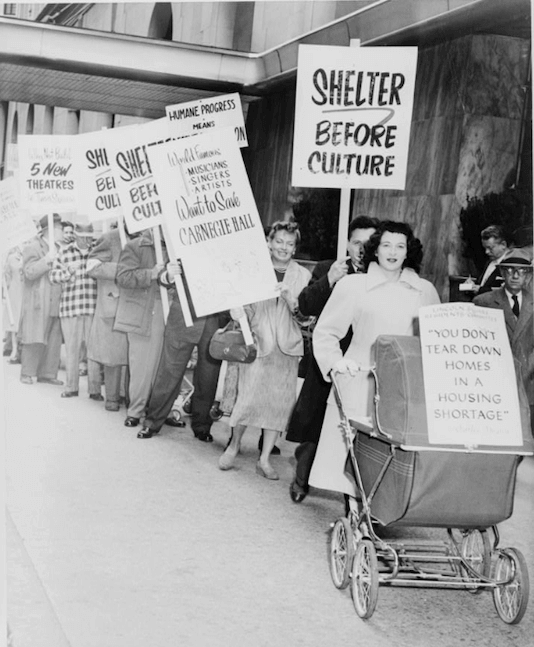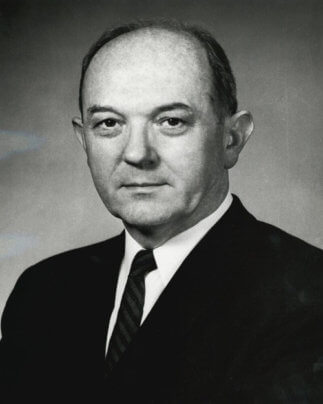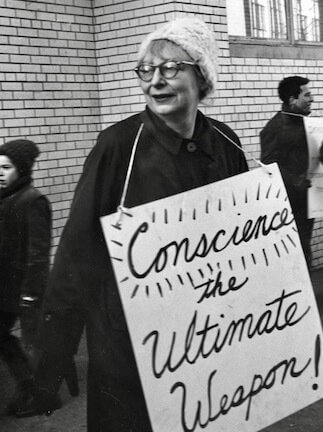Lincoln Center and Narrative Control
Arguably the most famous arts facility in the world, Lincoln Center is a present-day, glittering example of American urban renewal gone wrong.
Lincoln Center was the culminating project of Robert Moses, New York City’s planning czar and head of the Mayor’s Committee on Slum Clearance in the 1950’s. It replaced San Juan Hill, a Black and Puerto Rican neighborhood that offered local retail, stable housing for generations, and a vibrant jazz scene. These advantages, however, were not enough to save it from eminent domain and Moses’ bulldozers.
Federal urban renewal programs were ostensibly created to alleviate poverty, improve public health, and eliminate overcrowded conditions. More often than not, they actually led to mixed or worse conditions for those who the programs were supposed to help. For example, healthy housing advocates and the American Public Health Association, with the best of intentions, created housing and neighborhood standards that downgraded urban living, providing a scientific basis for condemning low-income housing and urban neighborhoods.
Advocates and scientists were not the only ones assisting Moses. The New York City Mayor’s office, the Rockefeller Foundation, the Metropolitan Opera, the New York Philharmonic (ironically, kicked out of Carnegie Hall due to a landlord dispute and the threat of a building demolition of that iconic hall), Fordham University, and other power brokers participated in the removal of San Juan Hill’s 7,000 families and 800 businesses. Almost none of the displaced residents were able to afford the higher rents in the project’s 4,400 high-rise apartment units, and relocation assistance never materialized. The Lincoln Square Renewal Project exemplified how middle class priorities of culture, arts and increased property values could take precedence over the needs of a working-class community.
Sixty years on, the memory of Lincoln Center/Square is for many still a mix of admitting to the wrongs committed against the San Juan Hill residents, while still justifying the project. A 2004 study prepared by the Economic Development Research Group seemed to praise the decision of Moses and the Committee on Slum Clearance by suggesting that “few people in the city and region even remember the slums and the violence that defined the Upper West Side of New York prior to Lincoln Center‘s establishment”. Calling Lincoln Square one of the “most vibrant residential and commercial areas of the city,” the report also accurately, if not misleadingly, shows the Center’s tremendous contributions to the city tax coffers.
The Rockefeller Foundation sought to clear its conscience in a 2019 report demonstrating its due diligence and internal debate at the time of the project. Concerned whether Lincoln Center would serve all of New York’s residents or just New York’s elite, “several of the Foundation staff …objected to the enterprise.” Foundation President Dean Rusk questioned “the propriety of condemnation proceedings [of public property] for what may be, in effect, private purposes.” The report stated that extensive surveys were conducted to assess the project’s impact on public transportation, surrounding businesses, and homes, though it likely hid the real, negative impact on the local residents. Additionally, the Rockefeller Foundation highlighted its financial support of urbanist Jane Jacobs, a Lincoln Center critic, noting that “despite backing Jacobs’s scholarship, the Foundation did not always support the causes backed by Jacobs herself.”
Lincoln Center represents the pinnacle of the arts in New York City and a profitable global brand for its cultural institutions. Unfortunately, fewer people remember the former, diverse community of San Juan Hill that was bulldozed to create the Center. By attempting to control the historical narrative, institutions that profited from the destruction of communities like San Juan Hill and others around the world, hope to diminish their roles in destructive, top-down urban renewal.
Article by Daniel Spiess, edited by Bob Potenza
Sources:“A Notoriously Jinxed Concert Hall Is Reborn, Again.” NYTimes. September 29, 2022. https://www.nytimes.com/2022/09/29/arts/music/david-geffen-hall-reopening-lincoln-center.html; “Urban Renewal and Its Aftermath.”.Housing Policy Debate, Volume 11, Issue 2. Pp. 443-465; “Public Health, the APHA, and Urban Renewal.” American Journal of Public Health, 2009 September; 99(9): 1603–1611.; “A Hand in Urban Design: Rockefeller Foundation Support for Renowned Urbanist Jane Jacobs and New York’s Lincoln Center.” Rockefeller Archive Center, November 2, 2019; “Revisiting San Juan Hill, the neighborhood destroyed to make way for Lincoln Center.” National Public Radio, All Things Considered. October 7, 2022.; “Lincoln Square Renewal Project (New York, 1955-1969):A case of culture vs. community.” ArcGIS StoryMaps, December 16, 2020; “How Lincoln Center Was Built (It Wasn’t Pretty).” NYTimes. December 21, 2017.; “The Economic Role & Impact of Lincoln Center (Prepared for Lincoln Center for the Performing Arts).” Economic Development Research Group. September 2004.













